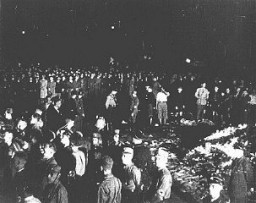You searched for: 余额宝理财系统搭建【TG���������@EK7676】平台包网搭建余额宝理财系统搭建【TG���������@EK7676】平台包网搭建1tVO4utgRM
<< Previous | Displaying results 126-150 of 652 for "余额宝理财系统搭建【TG���������@EK7676】平台包网搭建余额宝理财系统搭建【TG���������@EK7676】平台包网搭建1tVO4utgRM" | Next >>
-
White armband with blue Star of David
ArtifactWhite armband with a Star of David embroidered in blue thread, worn by Dina Offman from 1939 until 1941 while in the ghetto in Stopnica, Poland.

-
Torchlight parade in honor of Hitler's appointment as chancellor
PhotoFrom a window in the Reich Chancellery, German president Paul von Hindenburg watches a Nazi torchlight parade in honor of Adolf Hitler's appointment as German Chancellor. Berlin, Germany, January 30, 1933.
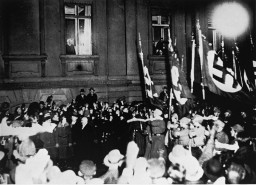
-
Ship used to deport Jews from Norway
PhotoThe Monte Rosa (right), one of the ships used to deport Jews from Norway to Germany. Norway, 1943.
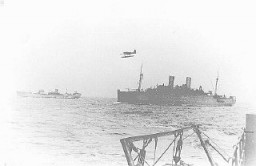
-
Public burning of "un-German" books in Berlin
PhotoPublic burning of "un-German" books in the Opernplatz (Opera Square) in Berlin. Students, some in SA uniform, march in a torchlight procession. Berlin, May 10, 1933.
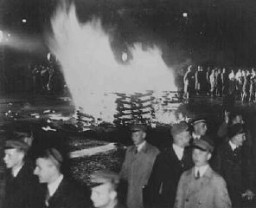
-
Adolf Hitler greets Paul von Hindenburg
PhotoAdolf Hitler, the newly appointed chancellor, greets German president Paul von Hindenburg. Berlin, Germany, January 30, 1933.
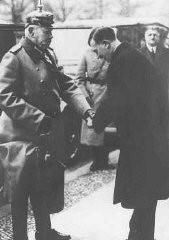
-
Jews captured during the Warsaw ghetto uprising
PhotoJews captured during the Warsaw ghetto uprising. Poland, April 19–May 16, 1943.
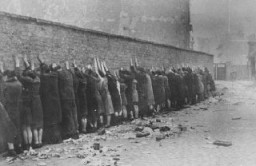
-
Postwar photo of a church in the village of Chelmno
PhotoPostwar photo of a church in the village of Chelmno. Jews were kept in this building en route to the Chelmno killing center. Chelmno, Poland, June 1945.
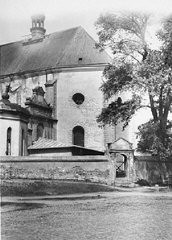
-
Jewish refugee children arrive in the United Kingdom
PhotoJewish refugee children, part of a Children's Transport (Kindertransport) from Germany, upon arrival in Harwich. Great Britain, December 12, 1938.
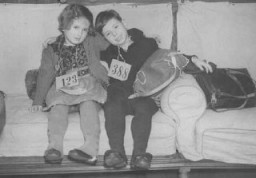
-
Deportation of Jews from Germany to Riga
PhotoJews in the town of Coesfeld, in northwestern Germany, assembled for deportation to the Riga ghetto. Coesfeld, Germany, December 10, 1941.
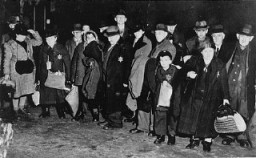
-
Agricultural training before emigration to Palestine
PhotoAn agricultural training farm to prepare Jewish refugees for life in Palestine, sponsored by the Joint Distribution Committee. Fuerth, Germany, June 13, 1946.
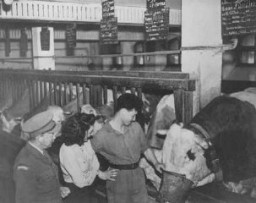
-
Footbridge that joined the two parts of the Lodz ghetto
PhotoThe footbridge over Zgierska Street that joined the two parts of the Lodz ghetto. The street itself was not part of the ghetto. Lodz, Poland, ca. 1941.
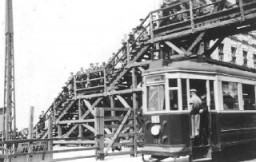
-
Regina at the Dueppel displaced persons camp
PhotoRegina (third from left) with friends while at the Dueppel displaced persons camp. Berlin, Germany, May 20, 1946.
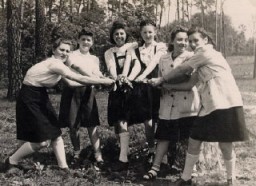
-
Page from an antisemitic German children's book
PhotoPage from the antisemitic German children's book, "Trau Keinem Fuchs..." (Trust No Fox in the Green Meadow and No Jew on his Oath). Germany, 1936.
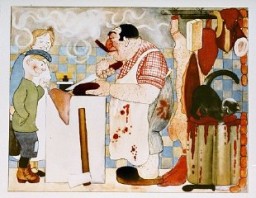
-
Scene of destruction during World War I
PhotoHouses along the River Meuse damaged during the Battle of Verdun, December 1916. The battle was one of the longest and deadliest of World War I. © IWM (Q 67594)
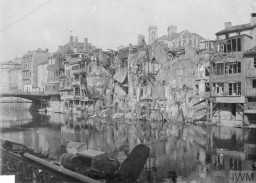
-
Booklet about International Military Tribunal
ArtifactFourth and fifth pages of a program booklet distributed during the International Military Tribunal at Nuremberg. Page four defines the charges of war crimes and crimes against humanity. The fifth page begins the list of IMT defendants. Handwritten notes in the margin record each defendant's sentence as it was read aloud in the courtroom.
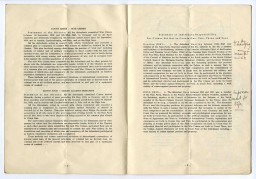
-
Matchbox cover with Japanese propaganda illustration
ArtifactDuring the war the Japanese flooded Shanghai with anti-American and anti-British propaganda, including this image from a matchbox cover. It depicts Japanese planes flying in formation over the U.S. and British flags, with the Japanese flag rising in triumph. Shanghai, China, between 1943 and 1945. [From the USHMM special exhibition Flight and Rescue.]
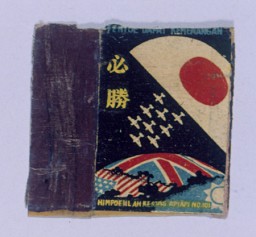
-
Portrait by refugee artist Yonia Fain
ArtifactPortrait of Semek Kushner, in pencil, by Yonia Fain. Kushner's father and brother were killed in Shanghai near the end of the war during an American air raid on Hongkew. [From the USHMM special exhibition Flight and Rescue.]
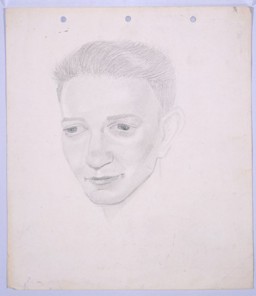
-
Polish citizenship certificate issued to Samuel Solc
DocumentThis page of a Polish citizenship certificate issued to Samuel Solc contains two visas. The first (left), stamped by the British Passport control in Shanghai, allowed Samuel to travel to Palestine via Burma, India, Egypt, and Rangoon. The second visa (right) bears the British Mandate "Government of Palestine" stamp, dated February 6, 1942, and allowed Samuel to remain in Palestine permanently. [From the USHMM special exhibition Flight and Rescue.]
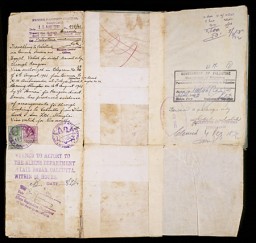
-
Defendant Hermann Göring listens to trial testimony
FilmDefendant Hermann Göring, seated at left in the dock, listens as US Chief Prosecutor Robert Jackson interrogates witness Albert Kesselring about the Luftwaffe (German Air Force).
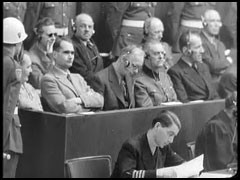
-
Inauguration of Paul von Hindenburg as President of Germany
Timeline EventMay 12, 1925. On this date, German Field Marshal Paul von Hindenburg is inaugurated, becoming the last president of the Weimar Republic.

-
Abraham Lewent describes conditions in the Warsaw ghetto
Oral HistoryLike other Jews, the Lewents were confined to the Warsaw ghetto. In 1942, as Abraham hid in a crawl space, the Germans seized his mother and sisters in a raid. They perished. He was deployed for forced labor nearby, but escaped to return to his father in the ghetto. In 1943, the two were deported to Majdanek, where Abraham's father died. Abraham later was sent to Skarzysko, Buchenwald, Schlieben, Bisingen, and Dachau. US troops liberated Abraham as the Germans evacuated prisoners.
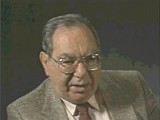
-
Belongings of Jews who were deported from Vienna
PhotoBelongings of Jews who were deported from Vienna. Austria, 1941–42.
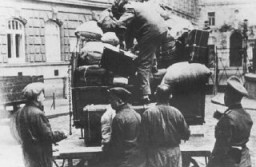
-
Jews from Bulgarian-occupied Macedonia before deportation
PhotoJews from Bulgarian-occupied Macedonia interned in the "Monopol" tobacco factory, which was used as a transit camp. They were ultimately deported to the Treblinka killing center. Skopje, Macedonia, March 1943.
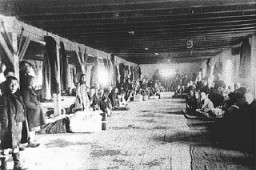
-
Ruins of the old synagogue in Aachen
PhotoView of the old synagogue in Aachen after its destruction on Kristallnacht. Aachen, Germany, photo taken ca. November 10, 1938.

-
Book burning in Berlin, Germany, May 10, 1933
PhotoAt Berlin's Opernplatz, crowds of German students and members of the SA gather for the burning of books deemed "un-German." Berlin, Germany, May 10, 1933.
